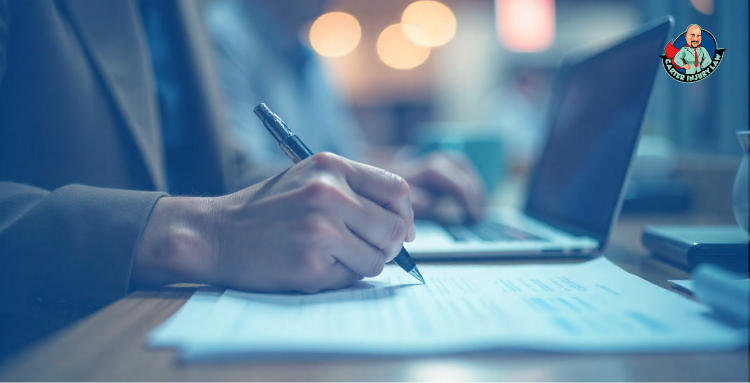
blog
March 20, 2025
Slip-and-Fall Secrets Revealed What You Must Know to Win Your Case

There’s a moment, just after it happens, when time seems to stand still. You’re lying there, on the cold floor of a supermarket or the hard pavement of a parking lot, and the world feels both distant and uncomfortably close. Embarrassment floods in first, followed quickly by a sharp pain or a dull ache that whispers: This isn’t how today was supposed to go.
Slip-and-fall incidents are rarely about the fall itself. They’re about what follows—the questions, the frustration, the realization that this wasn’t an accident at all, but the result of someone’s negligence. And while the world keeps moving around you, you’re left wondering how to make sense of it, how to make it right.
Carter Injury Law understands the chaos that comes after the fall. And more importantly, we’re here to help you rise.
(1) What Are Slip-and-Fall Cases?
Slip-and-fall cases are a type of premises liability claim, which means they arise when someone gets hurt because a property owner or establishment failed to maintain their premises in a reasonably safe condition. These cases are about more than just the fall itself—they’re about the responsibility a business or property owner has to the people who walk through their doors.
For example, when you enter a store, a restaurant, or even a residential property, you trust that the environment is safe. You’re not expecting hazards that could trip you up or cause you harm. Legally, that trust isn’t just a courtesy—it’s a standard of care that the property owner is obligated to uphold. If they neglect that duty and someone gets hurt, that’s where a slip-and-fall case comes into play.
(2) Common Causes of Slip-and-Fall Accident Cases

Slip-and-fall accidents can happen in a variety of ways. Let’s take a closer look at some of the most frequent causes:
Wet or Slippery Floors
This is one of the most common culprits. Whether it’s from spilled liquids, recently mopped floors, or even rainwater tracked in from outside, wet floors create a dangerous environment. Businesses have a duty to promptly clean up spills or post warning signs if the floor is still wet. If they don’t, it can lead to serious injuries.
Uneven Surfaces
Broken pavement, loose tiles, or uneven flooring may not seem like much at first glance, but they’re accidents waiting to happen. Walking on a surface that suddenly changes height or texture can easily cause someone to trip and fall. Property owners are expected to repair these issues or at the very least warn people of the hazard.
Poor Lighting
Without proper lighting, it becomes difficult to see obstacles or changes in the surface ahead. Poor lighting isn’t just inconvenient—it’s dangerous. Businesses must ensure their lighting is adequate to help prevent unnecessary accidents.
Obstructed Walkways
Walkways cluttered with boxes, merchandise, or other obstacles are a hazard to anyone trying to pass through. It’s the responsibility of the property owner or manager to keep pathways clear and accessible, ensuring that people can navigate the space safely.
Slippery Parking Lot Coatings
Parking lots might not be the first place you think of when it comes to slip-and-fall accidents, but they’re a common site for injuries. Sometimes, the surface of a parking lot is made slippery because the wrong type of paint or sealant was used. Facilities are often required to use non-slip coatings to prevent falls, but not all of them comply. When they fail to meet these standards, it puts everyone at risk.
(3) Where Do Slip-and-Fall Accidents Happen Most?

Slip-and-fall accidents can occur almost anywhere, but certain locations tend to see them more often. Let’s break it down:
Retail Establishments
Whether you’re shopping at a big-box store or a local boutique, retail spaces are a frequent site for slip-and-fall accidents. From slippery entranceways during rainy weather to merchandise cluttering the aisles, there are countless hazards if the store isn’t properly maintained. Retailers invite the public in, and with that invitation comes a legal responsibility to ensure the shopping environment is safe.
Restaurants and Supermarkets
In places where food and drinks are served or sold, the risk of slip-and-fall incidents increases. Spilled beverages, dropped food, and freshly mopped floors are all common hazards. Restaurants and supermarkets have a duty to address these issues quickly and make sure the public is warned about any potential dangers, like wet floors or broken tiles.
Public Spaces
Parks, sidewalks, and government-owned buildings are other places where slip-and-fall accidents frequently occur. In these spaces, the responsibility often falls on a municipality or public entity to maintain the area. That means ensuring sidewalks are even, stairways are safe, and any hazards are addressed promptly to avoid injuries.
Residential Properties
If you’re visiting an apartment complex, condominium, or private home, the property owner or landlord has a duty to keep the premises safe for guests. Hazards like broken steps, slippery driveways, or poorly lit pathways can lead to accidents and property owners can be held responsible if they fail to address these risks.
Most businesses and property owners carry general liability insurance to cover incidents like these. These policies are designed to protect them from the financial fallout of an injury claim. But just because they have insurance doesn’t mean they’ll admit fault or willingly compensate you for your injuries. That’s why it’s so important to understand your rights and work with someone who can advocate for you.
(4) What to Do if You Experience a Slip-and-Fall Incident

The steps you take immediately afterward can have a significant impact on your health, your recovery, and your ability to seek justice. Here’s what you need to do:
Report the Incident
The first step is to notify someone in charge—whether it’s an employee, manager, or property owner. Let them know what happened and where it occurred, and make sure an incident report is filed. This report creates an official record of the accident, which can be invaluable later. If possible, ask for a copy of the report for your own records. Keep in mind that in Florida, businesses are not required to give you a copy, but it never hurts to ask.
Seek Medical Attention
Your health should always be your top priority. Even if you think your injuries are minor, it’s crucial to get checked out. Many injuries from slip-and-fall accidents, like sprains, fractures, or even concussions, don’t always show immediate symptoms. Visit an urgent care clinic, see your primary care physician, or if necessary, go straight to the emergency room. In severe cases, don’t hesitate to take an ambulance.
Document Everything
While you’re still at the scene, try to gather evidence if you’re able. Take photos of the area where you fell, including any hazards like wet floors, poor lighting, or uneven surfaces. Make note of the time, date, and any witnesses who saw what happened. If someone else is with you, ask them to help you document these details.
Explore Our Blogs For Further Legal Insights:
What to Do After a Car Accident in Florida with Out-of-State Insurance
Can I Switch My Car Insurance Company During the Personal Injury Case?
(5) Let’s Talk About Your Case
The first thing you need to do is reach out to us for a free consultation. It’s not just some brief chat. It’s a moment for us to listen to your story, to understand the details of your accident, and to offer you clarity in a world full of confusion. If you’re burdened with medical bills, lost wages, or the endless back-and-forth with insurance companies, we’re here to help you find the best way forward.
In that consultation, we’ll make sure to answer every question you have and address the concerns you’ve been carrying. You shouldn’t feel lost, and you shouldn’t feel alone. Just an opportunity to get the answers you need and to understand how we can help.
We’re your advocates, your support, your partners in the pursuit of justice. If you’ve had a slip-and-fall accident, don’t wait. Call us now. Whether you want to meet face-to-face in our office or have a conversation over the phone, we’re here to offer you the attention and guidance you deserve.
Recent posts























